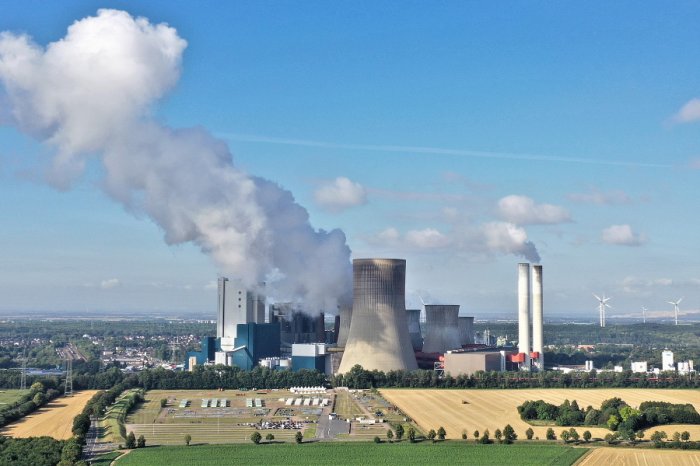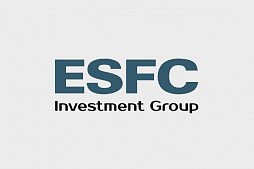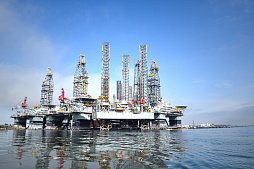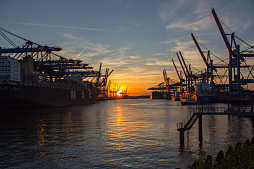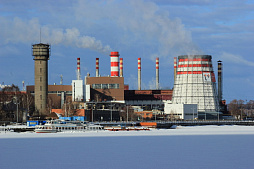To consider an application for financing, fill out the form and send it to us by e-mail along with the project brief, or contact our experts
LNG demand and production are expected to rise in the coming years, which will contribute to significant savings in many sectors and an acceleration of the global economy.
The construction of liquefied natural gas plants presents a huge investment opportunity for energy companies in Europe, the Middle East, North Africa and Latin America.
Morgan Stanley research shows that massive investments in new terminals, ships and LNG plants will soon pay off. According to the agency's estimates, the new capacity will lead to global growth of this market by 50% by 2025.
Costex Corporation DBA, a company with an international presence, offers financing and construction of LNG plants under an EPC contract.
For over 20 years our specialists have been offering financial and innovative solutions in the energy sector for private companies and government customers.
In this article, you will learn more about the prospects for investments in LNG plants, new technologies for the production of liquefied natural gas and our opportunities.
LNG production: new investment opportunities
Liquefied natural gas is a non-corrosive, odorless cryogenic liquid made up of 90% methane.Liquefied natural gas is a revolutionary fuel that could spur global economic growth over the next decade. It is becoming a more affordable fuel thanks to the development of technologies and the groeth of an extensive infrastructure for the production, transportation and regasification of LNG.
The LNG industry value chain consists of four links:
• Extraction of natural gas.
• Purification and liquefaction.
• Transportation.
• Regasification.
After extraction, natural gas is transported via pipelines to LNG plants, where it undergoes preliminary treatment.
This treatment removes all liquids and other components that may freeze (propane, butane, ethane, carbon dioxide and water). Then the gas is converted into a liquid state by deep cooling at atmospheric pressure, during which the volume is reduced by 600 times.
The resulting product is loaded onto LNG carriers, which are equipped with refrigeration and insulation systems to store and maintain the liquid state of the gas until it reaches the port of destination (LNG terminal).
The gas that evaporates during transportation is used as fuel.
In an LNG terminal, liquefied gas is vaporized during the heating process. The terminals have storage tanks that provide a continuous flow of gas into pipelines and cover peaks in demand.
Finally, after pressure regulation, natural gas is pumped into the main gas pipeline and sold to distributors or directly to power plants and large industrial consumers.
In some cases, liquefied is supplied to consumers by specially equipped tank trucks.
The importance of LNG for the global economy
In recent years, hydraulic fracturing has revolutionized the US energy sector, making the country the largest exporter of energy for the first time.However, until recently, the role of liquefied natural gas in the global economy was small due to the technical difficulties associated with transporting and storing this flammable gas.
Experts predict that cheap LNG exports in the coming years will reduce energy prices in Europe and Asia, thereby stimulating the energy sector and commodity markets.
In the late 1990s, concerns about oil shortages arose in developed countries. The emergence of hydraulic fracturing technology, which is used to release gas and oil under high pressure, has radically changed the situation in the energy market.
Natural gas prices have declined 80% since the mid-2000s, largely driven by exponential growth in shale gas production in North America.
Thanks to the boom in shale gas, coal consumption has fallen in half and CO2 emissions have fallen by 25%.
This is despite the fact that in those years it was very difficult to transport and store natural gas, and the main share of gas exports fell on expensive gas pipeline systems.
The situation changed with the advent of LNG: natural gas became liquid and it is now very easy to transport it by tanker trucks or ships. For this reason, experts are talking about big changes in the energy market, opening up investment opportunities for the next few years.

Economic implications of increased LNG production
Building new liquefied natural gas plants could forever change the gas market and the energy companies that make money from it.The LNG industry will affect the following companies:
• Engineering companies (EPC contractors).
• Transport companies (including ship owners).
• LNG equipment manufacturers.
• European chemical manufacturers.
• Other gas consumers.
Engineering and construction companies will clearly benefit from the introduction of the new fuel, as multibillion-dollar LNG production, transportation and regasification projects are under way around the world.
Industrial equipment manufacturers receive orders for new equipment and everything related to it. This represents a potential growth of 50% over the next five years over the previous decade.
Finally, chemical companies and other industrial gas consumers will benefit from reduced energy costs.
This will affect regional markets and change the direction of energy-intensive product flows.
The switch to LNG could put more pressure on other sectors, including those dependent on coal. Coal carriers may face a 5% decline in revenue in 2020 as more customers switch from coal to gas.
It should be noted that the construction of LNG plants around the world has a positive impact on the environment. Liquefied natural gas offers an alternative with lower CO2 emissions compared to solid fuels. However, the environmental benefits of switching to LNG vary greatlu.
Supply chain efficiency is key as distribution factors such as methane leakage can reduce these benefits.
Investment risks
In the LNG industry, long-term contracts are the main mechanism for ensuring coordination between all parts of the value chain.Such coordination is necessary because the production capacity of LNG plants is in many ways limited by the capacity of transport systems.
The liquefied natural gas industry has a high level of investment risk due to the small number of alternative uses for LNG plants, terminals and ships, as well as the high volume of investments. Until now, there is high uncertainty about large LNG projects.
The risk factors for the construction of LNG plants are as follows:
• Product prices are falling faster than costs.
• Concerns about security of demand (risk of recession).
• Conflicts in the distribution of gas supplies.
• Financial obstacles of all kinds.
• Environmental problems.
• Political tensions.
Uncertainty complicates the process of making investment decisions, since it is not known how much capacity will be commissioned in the coming years.
The risk is clear when you look at the delays that some companies face.
These delays are due to financial, environmental, social, regulatory and political issues. The planning, construction and commissioning times for LNG plants sometimes reach 4-6 years. During this time, the economic situation, demand and production can change significantly, so investors need accurate forecasts.
Liquefied natural gas plants: projects technology
Liquefied natural gas production is a proven technology that has been successfully used in the energy sector for many years.Typically, an LNG plant consists of the following elements:
• Gas pre-treatment and liquefaction line.
• LNG production equipment.
• Protected gas storage tanks.
• Equipment for loading gas carriers.
• Auxiliary systems.
The transformation of natural gas into a liquid state is carried out in several stages. In the first stage, impurities (primarily carbon dioxide and minimal residues of sulfur compounds) are removed.

Then water is removed, which can turn into crystals and damage the system.
The next stage is the removal of heavy hydrocarbons, after which mainly methane and ethane remain. Recently, for the purpose of complex gas purification from moisture, carbon dioxide and heavy hydrocarbons, the adsorption method of deep gas purification on molecular sieves has been used. The gas is then gradually cooled by passing through several heat exchangers (evaporators).
Purification and fractionation are carried out, like most cooling processes, under high pressure.
The temperature is reduced to -160C using refrigeration cycles. Under these conditions, natural gas becomes a liquid at atmospheric pressure.
The construction of LNG plants begins with the selection of the most suitable technology.
There are currently seven LNG production technologies in use worldwide, including AP-C3MR, AP-X, AP-SMR, MFC, PRICO, DMR, Liquefin and Optimized Cascade.
However, Air Products remains the industry leader.
The AP-SMR, AP-C3MR and AP-X processes developed by this company account for over 80% of the market.
The only competitor for these processes is Optimized Cascade technology from ConocoPhillips.
AP-SMR (single mixed refrigerant) is traditionally used for onshore LNG plants, typically with a capacity of up to 1 million tons per year per line. Several separate lines are needed to increase the capacity of the plant. A feature of the AP-SMR is a unified automated system that simultaneously controls several gas turbines. The use of a mixed refrigerant increases the efficiency of heat exchange.
AP-C3MR is often used in the construction of LNG plants.
This technology accounts for the vast majority of the world's liquefied natural gas production capacity. The AP-C3MR process uses two separate refrigerant cycles. The propane cycle is designed to pre-cool natural gas and partially dilute the refrigerant, and in some cases remove fuel gas (used for plant needs), while the mixed refrigerant cycle is used to liquefy and sublimate natural gas.
C3MR is a proven technology, proven over decades, making it suitable for many onshore plants. For floating LNG plants, this technology looks less attractive due to the large supply of propane, especially when kettle-type heat exchangers are used. Storing propane requires an increased strength tank where the working fluid is stored.
Since the C3MR process in floating LNG plants is of low appeal, Air Products has developed the more efficient AP-X technology (which is used in a number of large production lines in Qatar). An external nitrogen cycle is used to liquefy natural gas. Compression of nitrogen refrigerant is performed in three stages, which helps to optimize the process when there are significant fluctuations in natural gas flow.
The above technologies for the production of liquefied natural gas, as a rule, are used for the production of large volumes intended for further export.
Low-tonnage LNG plants also have a high development potential, meeting the demand of individual enterprises.
Estimated cost of building LNG plants
The gas industry is characterized by significant investment in infrastructure, unlike other solid or liquid energy sources that are easy to store and transport without an increased risk of loss.The fact that natural gas is difficult to extract and transport via gas pipelines to the consumer's boiler has slowed the development of the sector for many years.
It would seem that these disadvantages are not inherent in LNG, since it is transported in liquid form by sea like oil, without pipeline restrictions. But the fact that it must be liquefied and stored at low temperatures makes it difficult to handle and requires strict safety regulations.
Consequently, the LNG value chain also requires large investments.
Today, we see a reduction in capital costs at all links of the chain, including the production of LNG. This is happening both as a result of improving technologies and increasing capacities, and as a result of increased competition between technology and equipment suppliers, shipyards, etc.
Over the past 10 years, the cost of capital per unit of production at liquefied natural gas plants has decreased by 25%, for LNG tankers this figure has dropped by 35%, and at regasification terminals by 20% over the same period.
The cost of LNG plants can vary widely.
Building an LNG plant in Norway is not the same as implementing a similar project, for example, in Nigeria. Obviously, the availability of engineers, trained personnel, workshops and logistics services plays an important role.
Building a liquefied natural gas plant or receiving terminal near an existing port is not the same as building tens of kilometers from the sea coast. Floating LNG plants require a specific approach.
The approximate investment amounts given below are only averages and can vary greatly depending on the project conditions.
In the late 2000s, building an LNG plant from scratch with an estimated capacity of 8 million tons per year (MTPA) cost $ 1.5-2 billion.
Of this amount, 50% was for engineering design, construction and installation, 30% for the purchase of equipment, and the remaining 20% for building materials.

The previous example refers to large LNG plants designed to supply large existing markets.
On the other hand, when a company is about to open up a new market or cover an emerging shortage in a small market, it makes sense to build a smaller plant with the prospect of future expansion.
Building LNG plants with a lower capacity is more expensive in terms of MTPA.
Thus, a plant with a capacity of 4-5 million tons of LNG per year at the end of the 2000s cost about $ 1 billion.
Due to the reduction in the cost of technology and equipment, the cost of liquefied natural gas plants has dropped significantly, and the scale of projects has increased.
Our services in the field of construction of LNG plants
The company LBFL offers a full range of services in the field of financing and construction, modernization and expansion, maintenance and operation of liquefied natural gas plants in Europe, Latin America, North Africa and the Middle East.Services include:
• Feasibility study and financial modeling.
• Development of a general project and detailed design.
• Design and manufacture of customized LNG equipment.
• Construction and commissioning.
• Consultations during the operation of the plant.
• Modernization and expansion.
Cooperation with LBFL brings clear benefits to our customers in the form of favorable financing conditions, cost-effective production, high reliability, long equipment life and a quick return on investment.
We can design the optimal workflow for your business in order to simplify your LNG production scheme, saving on future plant expansion. A tailor-made approach contributes to reduced feed gas consumption, stable operation at low pressure and other benefits.
LBFL and partners help major energy companies around the world to achieve their goals.
In recent years, the EPC contract has become the most common form of cooperation in the construction of large-scale facilities such as LNG plants and terminals.
The advantage of an EPC contract for investors is that a single professional contractor performs all the work and bears full responsibility for the implementation of the project.
Contact us at any time to learn more about the construction of LNG plants under the EPC contract.





